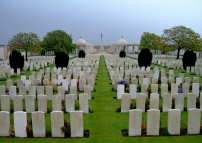| First Name: | Cecil | Last Name: | HAWTHORN | |
|---|---|---|---|---|
| Date of Death: | 25/09/1915 | Lived/Born In: | Wanstead | |
| Rank: | Private | Unit: | London19 | |
| Memorial Site: | 1. Wanstead Memorial 2. St. Pancras Parish Church 3. Loos Memorial, France | |||
Current Information:Age-18
35 Woodlands Avenue, Wanstead
The Battle of Loos, fought by the British Army from 25th September, 1915 through to 13th October, was conducted along a six-and-a-half-mile front running north from the mining village of Loos on the outskirts of Lens in Northern France. It was the largest offensive carried out by the British so far in the war. The opening day involved an attack by six divisions, with others entering the fray as it progressed and it was part of a much wider offensive with the French launching their own attacks in Champagne and at Vimy. It was the first time that the British used gas during the war, despite their condemnation of the Germans for doing the same in April 1915. There were some encouraging results on the first day but no major breakthrough was achieved and in the successive days the offensive became mired in trench warfare. By mid-October the battle had petered out with the British having suffered over 60,000 casualties during its course. On 25th September, 1915, 47th (2nd London) Division attacked on the right of the British line with French troops holding a passive front in front of Lens on their right. They held a 2500 yard front and had as their objectives the great dumps of Fosse 11 and Fosse 12, the Double Crassier and the Loos Crassier. The waste from these pits had been shot into the valley rather than built up into a pyramid, forming two high embankments. The Double Crassier was two 1200 yard long embankments about 100 feet high. The Loos Crassier was one 800 yard embankment, 150 feet high. At the north end of the Loos Crassier were the two lattice girder wheel houses. ‘Loos Pylon’ & ‘Tower Bridge’. The gas travelled well in this sector and there was also lots of smoke which concealed the advance. On the left, 141 Brigade had one assault battalion, 18th London (London Irish Rifles) with 20th London(Blackheath & Woolwich) following up on their right and 19th London (St Pancras) likewise on their left. At 6.30am, zero hour, they advanced from the Russian saps and assault trenches whilst at the same time 21st and 22nd London both of 142 Brigade used head and shoulder dummies to attract and divert German fire. 18th London advanced kicking a football and soon reached the Loos Defences trenches south of the cemetery. They were shallow and still wired but unmanned and at this stage 19th London and 20th London passed through to continue the attack. 20th London soon occupied ‘Garden City’ and then moved right to Chalk Pit Copse and Chalk Pit. The pit with its two field guns was captured after a hand grenade attack but the southern end of the copse was well defended and the Germans held out here. At 9.30am 20th London were reinforced by one company and the machine guns of 17th London (Poplar & Stepney Rifles). The rest of 17th London moved up to a German communication trench to link 20th London with 18th London. By now 20th London had a platoon astride the Loos Crassier. On the left 19th London were hit by cross fire as they advanced towards their objectives, the mine buildings at the north end of the Crassier known as the ‘Grand Stand’ and the Crassier of Puits 15. C Company took possession of the mine buildings after having pulled down the heavy wire netting, secured to iron uprights, that surrounded them and the Crassier. 19th London pushed on to a position half way up a ridge to keep up with the right flank of 15th Division but got mixed up with units of that division when passing through the village of Loos. Three companies of 19th London became separated from C Company that had consolidated on the right next to 20th London, some of them continuing on with 15th Division to attack Hill 70, whilst others to assembled in the village. Later 23rd London, 142 Brigade were sent up to to extend the left of 18th London to the Vermelles-Loos road. By 10am 47th Division were ready to deal with a counter attack from Lens or elsewhere to the west but unfortunately the attack came from the east against Hill 70 where the absence of most of 19th London had serious repercussions for the protection of the right of 15th Division. 47th Division’s casualties amounted to over 1400, most of them coming before 10am. 19th London had nearly 400 casualties. |
||||
| « Back to Search Results | ||||
| If you think any of the information shown here is incorrect, Click Here to submit your amends and comments | ||||




